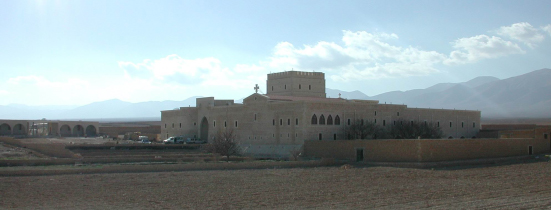
Technique: UNDERGROUND CATCHMENT TUNNELS - Monastery Syria
Project: Monastery of Saint Jacques, Restoring of a Qnat System
Site: Qara, SYRIA
LOCATION
 |
Continent: Asia
Country: Syria
Site: Quara
Coordinates:
34.16
36.72 |
BRIEF INTRODUCTION
The recently restructured monastery, represents a reference point not only for the Christian community of Qara, but also for those of Damascus and south-central Syria.
Seven qanāts lie in the area in question, but investigations concentrated on the Qanāt Ain el Taibeh, renovated in recent years thanks to the work of Sister Agnès Miriam de la Croix. In 1995 she initiated the restoration of the Monastery of Saint Jacques (Deir Mar Yakub), which stands over the remains of a Byzantine religious center northwest of Qara, and the redevelopment of the oasis for the cultivation of several kinds of fruit essential to the self-subsistence of the religious community.
PROBLEMS, CAUSES AND EFFECTS
The investigations carried out by Ipogea in the Qara Oasis from 27 December 2005 to 5 January 2006 fall within the framework of the Saduf Project (EU – INCOMED) and provide an overview of the territory concerned, especially concerning the ancient hydraulic systems (qanāt) used for water harvesting and irrigation. These systems have been severely damaged by the drilling of deep wells, which have lowered the level of the aquifer. In this perspective the iconographic information system (SITTI) used by the Traditional Knowledge World Bank was applied to the area of Qara, and to that of each oasis encountered along the qanāts. Detailed inspections were made at the Monastery of Saint Jacques (Deir Mar Yakub) as well as in the old town of Qara, rich in Byzantine-Roman and Arab influences, where the destruction of ancient raw-earth homes in favor of modern in reinforced-concrete constructions is advancing rapidly and merits special attention on the part of local authorities.
There are many reasons why the qanāts may have been abandoned. But it matters little if natural phenomena (diminished rainfall, earthquakes or floods, for instance) are to blame, or if the culprit is the large-scale introduction, from the 1950s onward, of power pumps enabling residents to draw water from deep wells: the implications for the social systems founded on water rights and water management are far-reaching. If previously the digging and maintenance of the qanāts called for a common effort for the common good, now each family and each farm can count on one or more wells for exclusively personal use, while the town is supplied by a modern aqueduct, also fed by three very deep wells (800m) dug during the 1980s by the Syrian government. To this issue one must add the migration of young generations abroad or toward big cities like Aleppo or Damascus—a movement that leads to the loss of the traditional knowledge and local learning that assured the correct functioning of these water works down through the centuries.
SOLUTIONS/PROJECT DESCRIPTION
The restoration work has made it possible to put back to work the three tunnels of the Ain el Taibech, a pool, and the sluiceways that irrigate the valley floor. At the same time, three Arab wells in the monastery cloister have been brought back to light, while the complex’s original church is undergoing renovation—together with its frescoes and architectural detailing (“pulvino” capitals, columns, etc.), of remarkable workmanship. There are also two ancient mills in the complex—an inner one that is difficult to access, and an outer one near the pool, which could not be visited at the time of the site inspection.
CONCLUSIONS
The oasis of Qara—meaning both the town and its territory—is not a part of the wide range of historic and archaeological itineraries Syria offers, but it has all the premises to become so. The public authorities need to give the old town and its renovation the attention they deserve. In addition, the reinstatement and preservation of the qanāts and wells situated in the surrounding countryside are key to the region’s sustainable development—particularly as they require the traditional knowledge and local learning which, for the reasons mentioned above, are vanishing, at Qara as in Damascus and throughout south-central Syria.
IMAGES

